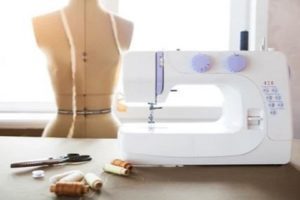
Sometimes the thread gets tangled, breaks or bunches under the fabric;
The needle bents or snaps repeatedly; stitches won’t come out as they should;
The needle won’t move; the sewing machine makes funny sounds;
Or the sewing machine refuses to budge, etc.
No matter what the case is, the experience is frustrating.
So, how to repair the sewing machine if something like that happens?
Do you need to haul it to a repair shop every time it acts out of character?
Nope, not at all. When you learn about every nook and cranny of your sewing machine, you can fix these common glitches at home in just a couple of minutes.
How to Repair a Sewing Machine?
Below is the list of some of the most common issues with their solutions.
Read on to know how to repair your sewing machine by yourself when it doesn’t work well.
Thread Bunches Under the Fabric
Sometimes you get picture-perfect stitches on a piece of fabric, but when you flip the material, there’s a bird’s nest there.
This bunching of thread under the fabric is usually because of incorrect threading, the difference between the top thread and the bobbin, or improper tension setting.
- First, cut all the threads to free the project under work. After that, carefully remove the thread from both the threading channel and the bobbin.
- Now, follow the threading channel and rethread your machine correctly. Make sure the presser foot is fully up during threading.
- Rethread the bobbin with the same thread you used for top threading. Insert it back in its place.
Check your machine’s tension settings. Adjust them per the type fabric type. You can either raise the take-up lever and needle to the highest point or do a few seams on scrap fabric to test the tension settings
Needle Bents or Breaks Frequently
This problem occurs when the needle is worn out or not of the right size. According to veteran sewists, always install a new needle before starting a new project.
Make sure you’re using the right type and size of the needle.
Needle sizes range from 8 to 18.
Heavy-weight materials like vinyl, leather or denim require a sharp and sturdy needle of size 16 or 18.
Similarly, sizes 9 or 11 are reserved for lightweight and delicate fabrics like silk, organza and chiffon. Size 14 is for medium-weight materials like linen and flannel.
- The second the needle bents or breaks, halt the sewing.
- Dispose of the damaged needle and install the new one correctly.
- If the issue remains, then you might have some mechanical issue that will require an expert’s hands.
Skipped or Uneven Stitches
If your machine is erratically delivering uneven stitches or skipping them altogether, most of the time needle is responsible for that.
Another possibility is that you might be pulling the fabric a little too forcefully from behind to force it through the feed dogs.
A third possibility is that the top thread is not locking properly with the bobbin’s thread.
- See if you have used the right needle and whether it is placed correctly.
- Make sure the fabric is smoothly going over the feed dogs and stays in place when the needle pierces through it.
- Rethread both the top thread and the bobbin to resolve the issue.
Thread Breaks Frequently
It is so annoying when the thread keeps breaking while you’re trying to finish the project.
If this happens frequently, you should ask yourself, “Am I using the right thread?”
Threads designed for hand sewing are delicate and not suitable for sewing machine use.
- Use a good quality thread. Make sure its strength works for the type of material you plan to sew.
- You should use thread of the same weight and filament for threading both the top and bottom of the machine.
Machine Refuses to Sew or Halts Midway
If the machine won’t sew, check the obvious first: Have you turned the switch on or not? Is every part exactly in a position where it is supposed to be?
- Rotate the handwheel a little to help the machine get into motion. If it still doesn’t pick up the pace and needs constant assistance, then the fabric is probably too difficult for your machine to handle.
- If the machine is humming but the needle refuses to budge, you might have forgotten to turn off the bobbin winder mode. Look for a switch to turn it off.
- If the case is reversed, i.e. the needle is moving, but the fabric isn’t, you might have accidentally turned the switch off for the feed dogs. Simply, flip the switch to on.
- If the machine still doesn’t run smoothly, there might be dust or lint build-up. Clean it and then oil it as per the instruction manual.
The machine is Making Funny Noises
It is not uncommon for a sewing machine to make weird noises.
It is a code that something is wrong with your appliance. This often happens when you haven’t cleaned and oiled the machine for quite some time.
- When strange noises come out of your machine during sewing, stop it immediately!
- Follow the maintenance procedure stated in the manual to properly clean your sewing machine.
- Oil it with proper sewing machine oil.
- Test it on a scrap. If there are still funny sounds coming out of it, it likely needs a trip to a repair shop.
Conclusion
These are some of the most common misbehaviors often witnessed in sewing machines.
You can find a fix for these issues at home.
All you need is to know the mechanics of your sewing machine and the common causes of such ordinary problems to repair the unit without spending money.